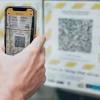In pictures: Aurora australis makes spectacular return to New ...


An image of the aurora australis taken with an iPhone 14 at Lake Ellesmere, Canterbury on 11 October 2024. Photo: Shanelle Siaki / Supplied
The aurora australis has made a spectacular return to New Zealand skies, with people reporting displays of the Southern Lights from all parts of the country on Friday night.
This year, the Southern Lights have been unusually active, as the Sun undergoes a period of intense activity, which occurs in 11-year cycles.
Have you seen the aurora australis? Send images to iwitness@rnz.co.nz
In Canterbury, residents drove to Lake Ellesmere to capture the aurora reflected off the water. Shanelle Siaki was there around 9pm and captured a number of images on her iPhone 14.

An image of the aurora australis taken with an iPhone 14 at Lake Ellesmere, Canterbury on 11 October Photo: Shanelle Siaki / Supplied
Also at Lake Ellesmere was Natalie Crowther, who took family members to her favourite spot for star-gazing and aurora-spotting.

An image of the aurora australis at the peak of its display, taken by Natalie Crowther at Lake Ellesmere in Canterbury. Photo: Natalie Crowther / Supplied
Read more:
Northwest of Auckland, at Muriwai Beach, Kasuy Gonzaga captured an image of the moon framed by the aurora.

Kasuy Gonzaga captured this shot of the moon and the aurora australis at Muriwai Beach, northwest of Auckland Photo: Kasuy Gonzaga / Supplied
At Karioitahi Beach, south of Auckland, Simon Jarman (@sjarmanphoto) said it was a "decent show" on Friday, posting on NZ Dark Skies the aurora "went off" around 9pm, "died down then came back around 11.15". His shot was taken facing west.

An image of the aurora australis taken from Karioitahi Beach, south of Auckland on 11 October. Photo: SIMON JARMAN PHOTOGRAPHY / SUPPLIED
Meanwhile in south Auckland, Katrina Piggott described the skies around Papakura looking "pretty in pink tonight".

Katrina Piggott captured this image of the aurora australis in Papakura, south Auckland. Photo: Katrina Piggott / Supplied
Further north, RNZ's Northland reporter Peter de Graaf captured an image of a glowing purple night sky late on Friday night at Marsden Cross, Rangihoua Heritage Park, in the northern Bay of Islands.
He said the aurora was barely visible with the naked eye, but the colours were revealed with a long, 15-second exposure.

Photo: Peter de Graaf
Many in the Northern Hemisphere have also been sharing images of the Aurora borealis this week.
Aurora boreal en el desierto de Sonora, México. 10/Oct/2024 Tormenta Geomagnética. pic.twitter.com/yfQn0fh1hn
— Gerardo L Gerardo-Fotografia (@GGerardox2) October 11, 2024
The aurora displays are related to activity from the Sun.
Usually particles from solar flares bounce off the Earth's magnetic field, but when there is a severe eruption, they can penetrate the ionosphere and interact with gases around the magnetic poles - causing the ribbons of colour.
Auroras are usually confined to certain latitudes in the north and south, which makes them relatively rare to observe for most of the population.
The pinks, purples and greens that are often associated with aurora are the particles interacting with different gasses. Simply put, oxygen - which emits greenish-yellow or red light - and nitrogen - which emits blue light - in the upper atmosphere release specific colours when bombarded by solar radiation.
Atoms, molecules and ions in the atmosphere are excited by the electrically charged particles and, in turn, release photons - which is the light we see.


 New Zealand
New Zealand Argentina
Argentina  Australia
Australia  Austria
Austria  Brazil
Brazil  Canada
Canada  Chile
Chile  Czechia
Czechia  France
France  Germany
Germany  Greece
Greece  Italy
Italy  Mexico
Mexico  Nigeria
Nigeria  Norway
Norway  Poland
Poland  Portugal
Portugal  Sweden
Sweden  Switzerland
Switzerland  United Kingdom
United Kingdom  United States
United States 







































